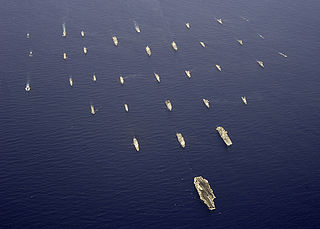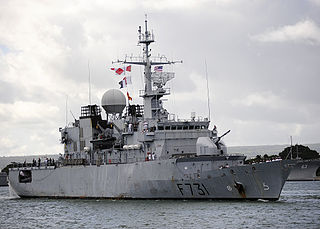
The Hibiki-class ocean surveillance ship is a class of surveillance ships operated by the Japan Maritime Self-Defense Force. [1] [2] The ships have a small-waterplane-area twin hull (SWATH) design. [3]

The Hibiki-class ocean surveillance ship is a class of surveillance ships operated by the Japan Maritime Self-Defense Force. [1] [2] The ships have a small-waterplane-area twin hull (SWATH) design. [3]
The Hibiki class was developed in response to the launch of the Kilo-class submarines by the Soviet Union, and their deployments in the waters near Japan. [4] The Defense Agency announced plans to develop a surveillance ship in 1989. [4]
The first Hibiki-class vessel was commissioned on January 23, 1991, and the second, Harima, on March 10, 1992. [5]
All three vessels of the class have been built by Mitsui Engineering & Shipbuilding at its Tamano shipyard. [1]
Hibiki and Harima operate out of Kure, Hiroshima. [4] The United States and Japan reportedly split the costs of operating the Hibiki vessels, which approximately US$20 million per year. [4]
Hibiki-class vessels have a beam of 30 metres (98 ft 5 in), a top speed of 11 knots (20 km/h; 13 mph), and a standard range of 3,800 nautical miles (7,000 km; 4,400 mi). [6] Each vessel has a crew of 40, including five American civilian technicians, and a flight deck for helicopters to operate off of. [1] [7] They are able to deploy on station for 90 days. [7]
The vessels have an AN/UQQ-2 Surveillance Towed Array Sensor System (SURTASS), which is installed in the United States. [2] [7] Data from the sensors is relayed through the Defense Satellite Communications System, and processed and shared with the United States. [7] The data is fed into the Integrated Undersea Surveillance System. [4]
Propulsion is provided by four Mitsubishi S6U-MPTK diesel electric engines. [3] The third ship was equipped with a Daihatsu diesel MTU. [8]
| Pennant no. | Name | Laid down | Launched | Commissioned | Home port | Notes |
|---|---|---|---|---|---|---|
| AOS-5201 | Hibiki | 28 November 1989 | 27 July 1990 | 30 January 1991 | Kure | |
| AOS-5202 | Harima | 26 December 1990 | 11 September 1991 | 10 March 1992 | Kure | |
| AOS-5203 | Aki | October 2018 | 15 January 2020 | 4 March 2021 | [1] | |
| FY Reiwa4 AOS [9] | TBA | TBA | TBA | TBA |

A small waterplane area twin hull, better known by the acronym SWATH, is a catamaran design that minimizes hull cross section area at the sea's surface. Minimizing the ship's volume near the surface area of the sea, where wave energy is located, minimizes a vessel's response to sea state, even in high seas and at high speeds. The bulk of the displacement necessary to keep the ship afloat is located beneath the waves, where it is less affected by wave action. Wave excitation drops exponentially as depth increases, so wave action normally does not affect a submerged submarine at all. Placing the majority of a ship's displacement under the waves is similar in concept to creating a ship that rides atop twin submarines.

A blue-water navy is a maritime force capable of operating globally, essentially across the deep waters of open oceans. While definitions of what actually constitutes such a force vary, there is a requirement for the ability to exercise sea control at long range.

Prairial is a Floréal-class frigate of the French Navy. She is the second ship of the class, and the second French warship named after the ninth month of the Republican Calendar. The ship was constructed by Chantiers de l'Atlantique at Saint-Nazaire, France, in 1992 and entered service in 1993. Prairial is stationed in the French Pacific territories for patrol duties.

Nivôse is a Floréal-class frigate of the French Navy. The frigate is the third ship of the class and the fourth French vessel named after the fourth month of the Republican Calendar. Nivôse was constructed by Chantiers de l'Atlantique at Saint-Nazaire, France, in 1991 and entered service in 1992. The frigate is stationed at Réunion in the Indian Ocean for patrol duties.

HMCS Ville de Québec is a Halifax-class frigate that has served in the Canadian Forces and Royal Canadian Navy since 1993. Ville de Québec is the third vessel in her class which is the name for the Canadian Patrol Frigate Project. The frigate is the second Royal Canadian Navy ship to be named Ville de Québec and is Canada's only fully bilingual warship. She is assigned to Maritime Forces Atlantic (MARLANT) and is homeported at CFB Halifax. The vessel serves on MARLANT missions protecting Canada's sovereignty in the Atlantic Ocean and enforcing Canadian laws in its territorial sea and exclusive economic zone.

The Dokdo-class amphibious assault ship is a class of landing platform helicopter (LPH) and amphibious assault ships operated by the Republic of Korea Navy (ROKN). Designed and built by Hanjin Heavy Industries (HHIC), the amphibious landing ships were meant to enhance South Korea's amphibious operation capability in terms of assault and military operations other than war (MOOTW).

USNS Stalwart (T-AGOS-1) was a Modified Tactical Auxiliary General Ocean Surveillance Ship and the lead ship of her class.

USNS Invincible (T-AGM-24), also known as ex-AGOS 10, is one of two tracking ships operated by the Military Sealift Command. One of the radars it carries is the Cobra Gemini dual band, X band and S band, radar.

The USNS Worthy (T-AGOS-14) was a modified Stalwart-class ocean surveillance ship operated by the United States Navy.

The Holland-class ocean-going patrol vessels are a class of four ocean-going patrol vessels constructed for the Royal Netherlands Navy. They are designed to fulfill patrol and intervention tasks against lightly armed opponents, such as pirates and smugglers, but have much higher level electronic and radar surveillance capabilities which are used for military stabilization and security roles, short of outright war. Without sonar or long range weapons, they utilize the surveillance capabilities of the Thales integrated mast, which integrates communication systems and two 4-faced phased arrays for air and surface search.

The ASW Continuous Trail Unmanned Vessel (ACTUV) is a DARPA funded project launched in early 2010 to develop an anti-submarine drone. ASW is an acronym for Anti-Submarine Warfare. In January 2018 after successful sea trials it was announced that the "Sea Hunter" prototype has transitioned from DARPA to the Office of Naval Research for further development.
Liquid Robotics is an American marine robotics corporation that designs, manufactures and sells the Wave Glider, a wave and solar powered unmanned surface vehicle (USV). The Wave Glider harvests energy from ocean waves for propulsion. With this energy source, Wave Gliders can spend many months at a time at sea, collecting and transmitting ocean data.

The Sandhayak-class survey ships are a series of eight vessels built by Garden Reach Shipbuilders and Engineers (GRSE), Kolkata and Goa Shipyard, Ltd., Vasco for the Indian Navy. While Sandhayak, Investigator, Nirdeshak, Nirupak were built in GRSE; Sarveshak, Jamuna, Darshak, Sutlej were built by Goa Shipyard. The vessels equipped with four survey motor boats, two small boats and are powered by two diesel engines with a top speed of 16 knots. They have a helicopter deck and are also armed with a Bofors 40 mm/60 gun mount for self-defense.

BRP Gregorio del Pilar (PS-15) is the lead ship of her class of offshore patrol vessel of the Philippine Navy. She is the second ship to be named after Gregorio del Pilar, a Filipino revolutionary general known for his role at the Battle of Tirad Pass. She was originally designated as "PF-15" from 2012 to mid-2016. Then the Navy adopted a new code designation system and she was redesignated as "FF-15". In February 2019, the Navy downgraded the status of the entire class from frigate to patrol ship and redesignated her to "PS-15".

JS Samidare (DD-106) is the sixth Murasame-class destroyer of the Japan Maritime Self-Defense Force (JMSDF). She was commissioned on 21 March 2000.

JS Hibiki (AOS-5201) is a Hibiki-class ocean surveillance ship of Japan Maritime Self-Defense Force.

JS Harima (AOS-5202) is a Hibiki-class ocean surveillance ship of Japan Maritime Self-Defense Force.

JS Aki (AOS-5203) is a Hibiki-class ocean surveillance ship of Japan Maritime Self-Defense Force.

The Integrated Coastal Surveillance System (ICSS) is a coastal surveillance system operated by India with the goal to protect its coastline, ensure regional security, and assist friendly navies by quickly detecting, locating and monitoring maritime activity in the Indian Ocean. The system was developed by the Defence Research and Development Organisation (DRDO) and Bharat Electronics, and forms part of the National Command Control Communication and Intelligence System (NC3I). Although the ICSS was built primarily for coastal and maritime security, the system can also be used for vessel traffic management, harbour surveillance and navigation. The core of the ICSS is a network of remote ground-based radar stations called the Coastal Surveillance Network (CSN). In addition to radars, stations are also fitted with optical sensors, electro-optical sensors, thermal imagers, cameras, meteorological systems, an Automatic Identification System (AIS), a distress alert transmission system (DATS), electronic warfare support measures, and very high frequency (VHF) radio communication systems.